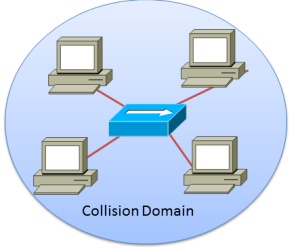- CCNA exam success depends on mastering the fundamentals, and two important fundamentals are knowing exactly what the terms “collision domain” and “broadcast domain” mean. In this free Cisco tutorial, we’ll take a look at the term “collision domain” and how a collision domain is defined.

A collision domain is an area in which a collision can occur. Fair enough, but what “collision” are we talking about here? We’re talking about collisions that occur on CSMA/CD segments, or Carrier Sense Multiple Access with Collision Detection. If two hosts on an Ethernet segment transmit data at exactly the same time, the data from the two hosts will collide on the shared segment. CSMA/CD exists to lessen the chances of this happening, but collisions can still occur. To lessen the chances of collisions occurring, we may decide to create multiple, smaller collision domains.Let’s say we have four hosts on a single Ethernet segment. The entire segment is a collision domain; any data sent by one of the hosts can collide with data sent by any of the other hosts. We have one collision domain containing four devices.To create smaller collision domains, we’ll need to introduce some type of networking device into this example. Hubs and repeaters have their place as far as extending the reach of a network segment and cutting down on attenuation, but these OSI Layer One devices do nothing to define collision domains. We could connect each host into a separate port on a hub (a hub is basically a multiport repeater) and we’d still have one single collision domain with four hosts in it.The most common and most effective way to create multiple collision domains is to use a switch. If we connect each of these four hosts to their own separate switch port, we would now have four separate collision domains, each with one host; each switch port actually acts as a single collision domain, making collisions between these four hosts impossible.Passing the CCNA is all about knowing the details of how things work, and knowing CSMA/CD theory and how to define collision domains is one of the many details you’ve got to master. In the next part of this CCNA tutorial, we’ll take a look at broadcast domains, and how defining broadcast domains in the right places can dramatically cut down on unnecessary traffic on your network.
- A collision domain is defined as a group of hosts whose data can be involved in collisions if they transmit at the same time. If three PCs are all on the same network segment, that’s a collision domain. To many newcomers to networking, it sounds like you’d rather have one large collision domain than multiple smaller ones. That’s what I thought as well when I started! What you must keep in mind is that the smaller the collision domain, the smaller the number of hosts in the domain – and the fewer hosts we have in a collision domain, the less chance we have of collisions.And wouldn’t it be great if we could create a collision domain with only one host? Well, we can, thanks to switches!Traditional switches run at Layer 2 of the OSI model, with many new switches able to operate at both the data link (L2) and network (L3) layers. Switches help to eliminate the chance of collisions because each port on the switch is actually its own little collision domain! If we take the three PCs mentioned before and connect them each to their own switch port, they literally cannot be involved in collision with each other – and in networking, we’ll take all the guarantees we can get!While switches do help lower the number of collisions, by default they’re not much help with broadcasts.
